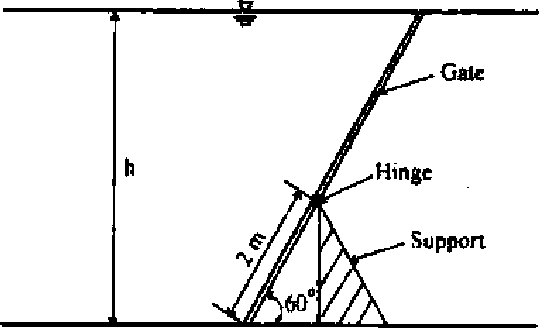Thapar University 2007 B.E FLUID MECHANICS - Question Paper
THAPAR UNIVERSITY,PATIALA
B.TECH(DISTANCE EDUCATION),SEPTEMBER 2007
FLUID MECHANICS
THAPAR UNIVERSITY, PATIALA B. TECH (DISTANCE EDUCATION) EXAMINATION, SEPTEMBER, 2007 FLUID MECHANICS (CE 001D)
TIME ALLOWED = 3 HOURS
MAXIMUM MARKS = 100
NOTE: ALL QUESTIONS ARE COMPULSORY
Ql:
(i) State and explain Newtons law of viscosity.
(ii) Explain absolute, gauge and the vacuum pressures with the help of a sketch.
(iii) The pressure at the bottom of lake is 1.5 times that at half the depth. If water barometer reads 10 m, what is the depth of the lake?
(iv) Define steady, unsteady, uniform and non-uniform flows. Give examples.
(v) Define metacentre and metacentric height.
(vi) Define HGL and TEL with the help of a diagram.
(vii) An oil of specific gravity 0.85 and viscosity 3.8 poise flows in a 5 cm diameter horizontal pipe at the rate of 4 litres per second. Comment whether flow is laminar or turbulent.
(viii) What do you under stand by equivalent pipe? How will do you determine diameter of equivalent pipe?
(ix) What is model analysis and what are the advantages of model testing?
(x) Differentiate between a pipe flow and a channel flow.
(a) A conical thrust bearing idealized as a cone of vertex angle 60, maximum cone diameter 200 mm, rests and revolves over a uniform fluid iayer of thickness 1 mm at 600 rpm. If viscosity of fluid layer is 1 P, calculate power lost in the bearing.
|
(b) The velocity components in a 2D flow field for an incompressible fluid are: |
 |
|
Show that velocity potential (<b) exists and determine its form. |
(a) A hollow cone of diameter 2 m and height 4m is floating in water in the upright position, with its vertex downward. The weight of cone is 37.3 kN. Find metacentric height of the cone.
(b) A gate supporting water is shown in Figure 1. Find the height h of the water so that the gate just begins to tip about the hinge. Width of the gate is 1.5 m.
 |
|
Figure I |
Q4:
(a) Derive continuity equation for 3D flow in Cartesian coordinates.
(b) A 250 mm diameter and 3 km long straight pipe connects two reservoirs of surface elevation 135 m and 60 m. A 1.5 km long, 300 mm diameter pipe is laid parallel to 250 mm diameter pipe from its mid-point to the lower reservoir. Find the percentage increase in discharge. Neglecting minor losses and assuming friction factor as 0.02 for both the pipes.
05:
(a) The pressure rise, Ap generatedrby a pump is a function of the impeller diameter D, rotational speed N, fluid density p, dynamic viscosity ji and discharge Q. Establish a relational among the variables by using Buckingum method of dimensional analysis.
(b) A venturimeter is used for tfie measurement ot discharge in a horizontal pipe of diameter 300 mm. If the ratio of pipe diameter to that of throat is 2 :l and the difference in pressure between the upstream and throat of venturimeter is 3 m head of water. Calculate discharge in the pipe if the loss of head through the meter is one-eight of the throat velocity head.
Q6:
What is a centrifugal pump? Draw a sketch of the same and explain its working.
(a)
(b)
Find the discharge through a trapezoidal channel of width 6 m and sides lopes of 1 horizontal to 3 vertical. The depth of flow of water is 3 m. The channel is laid at slope of 1 in 5000. Take Chezvs constant = 60 in SI units.
|
Attachment: |
| Earning: Approval pending. |
